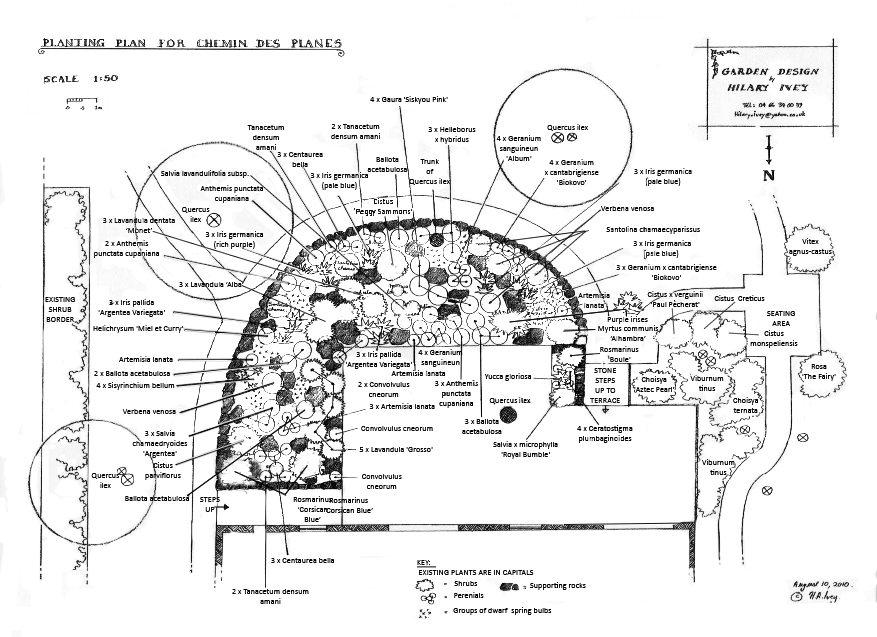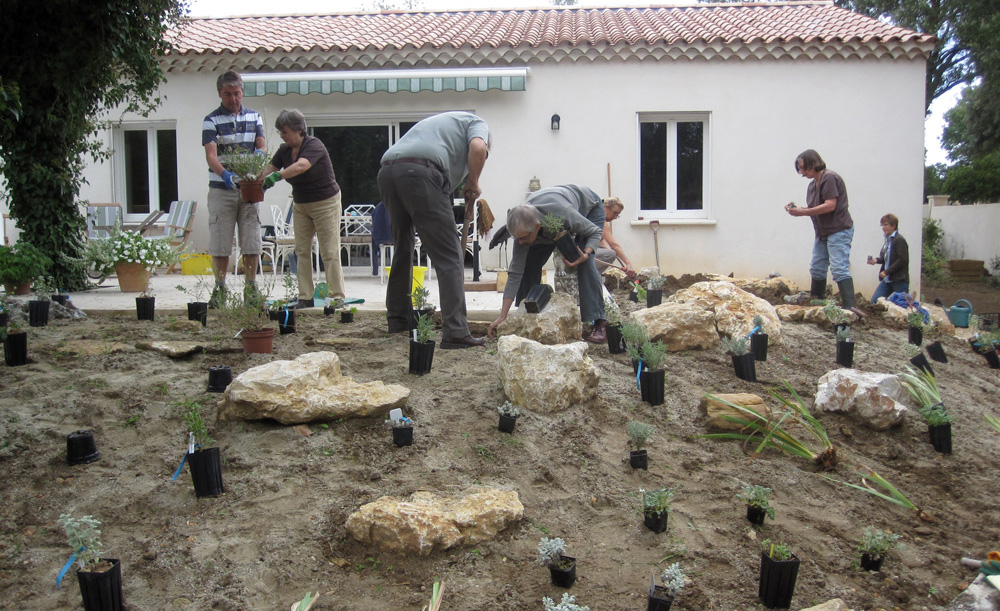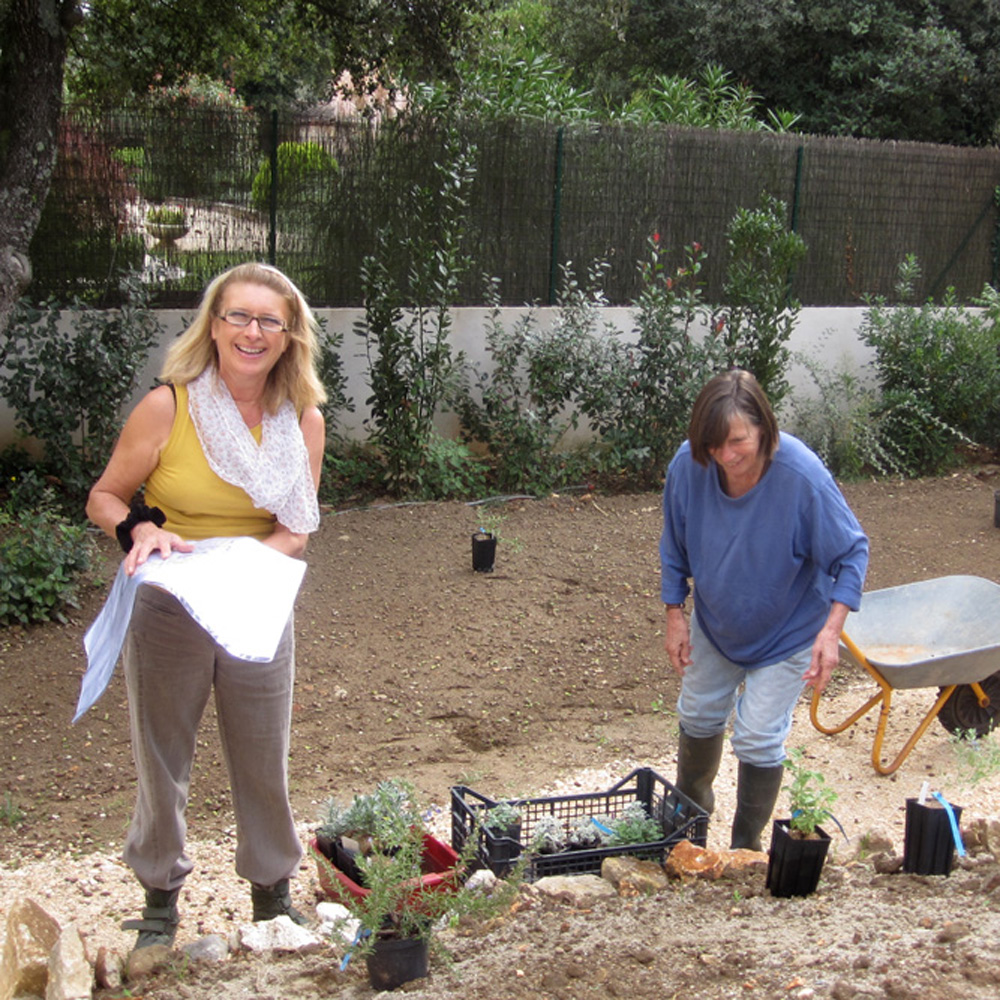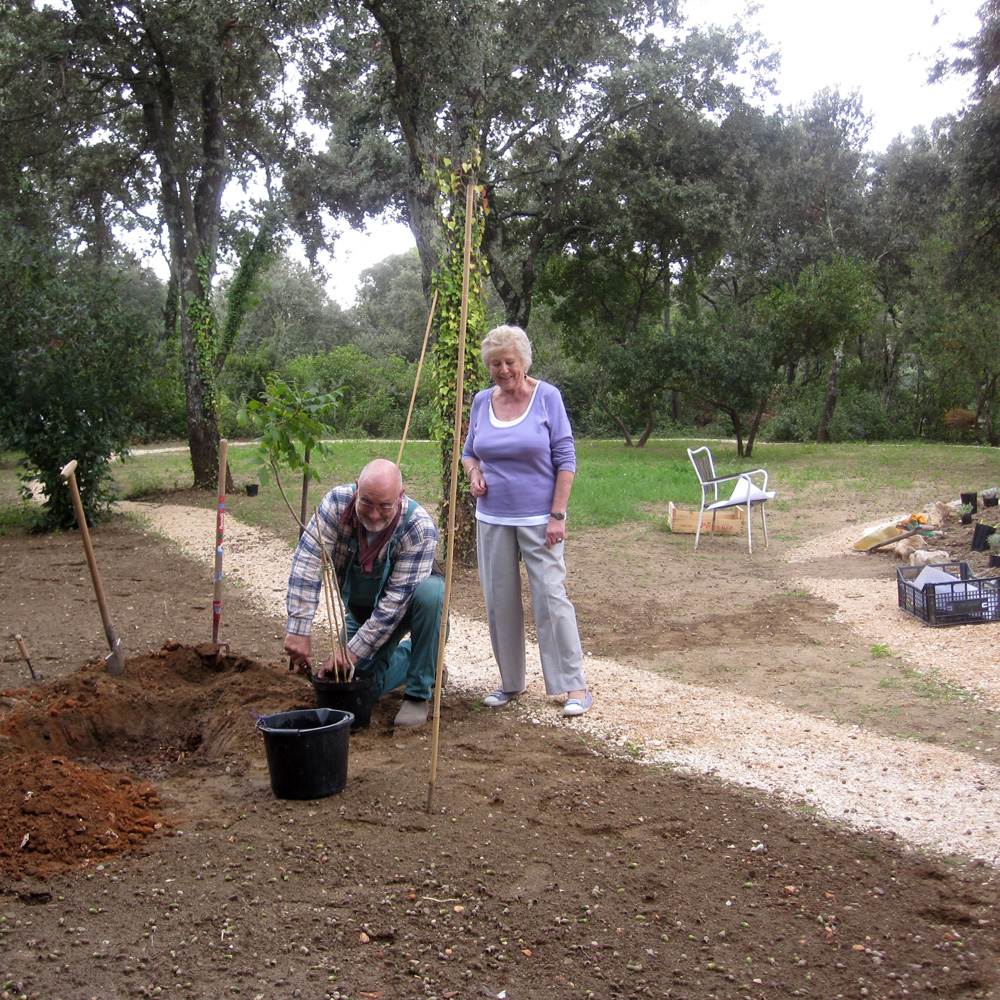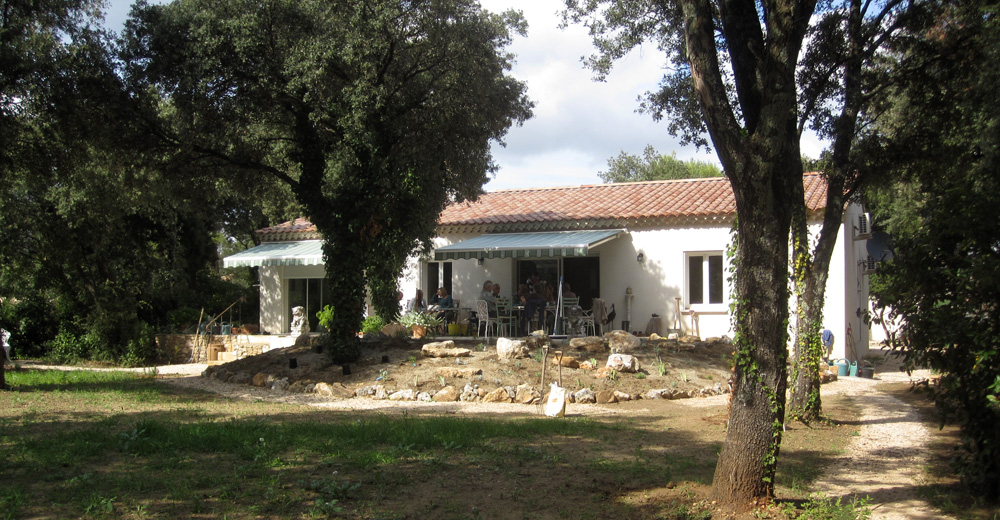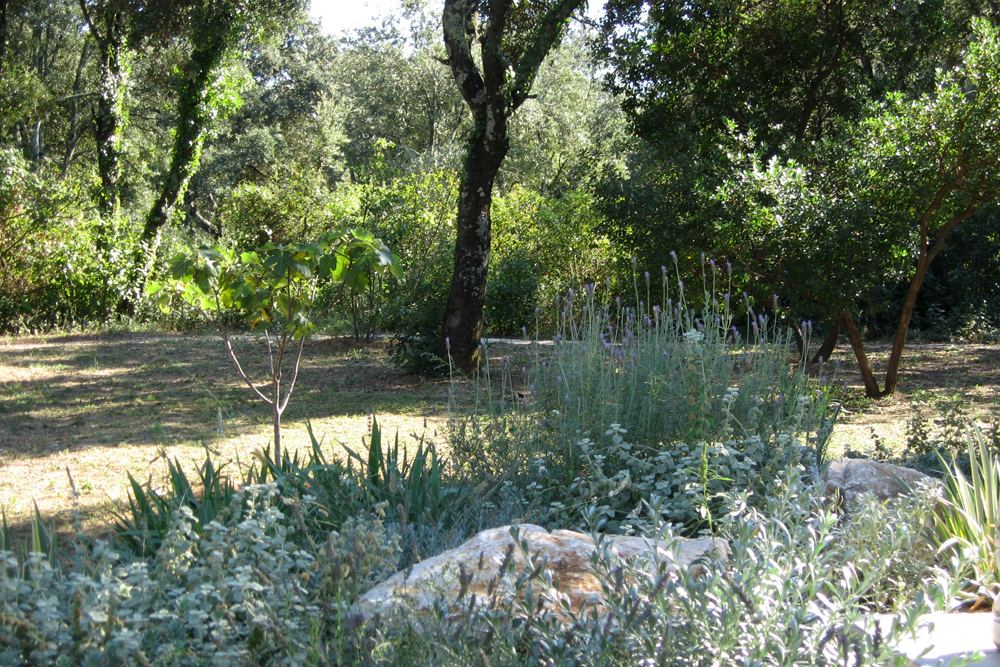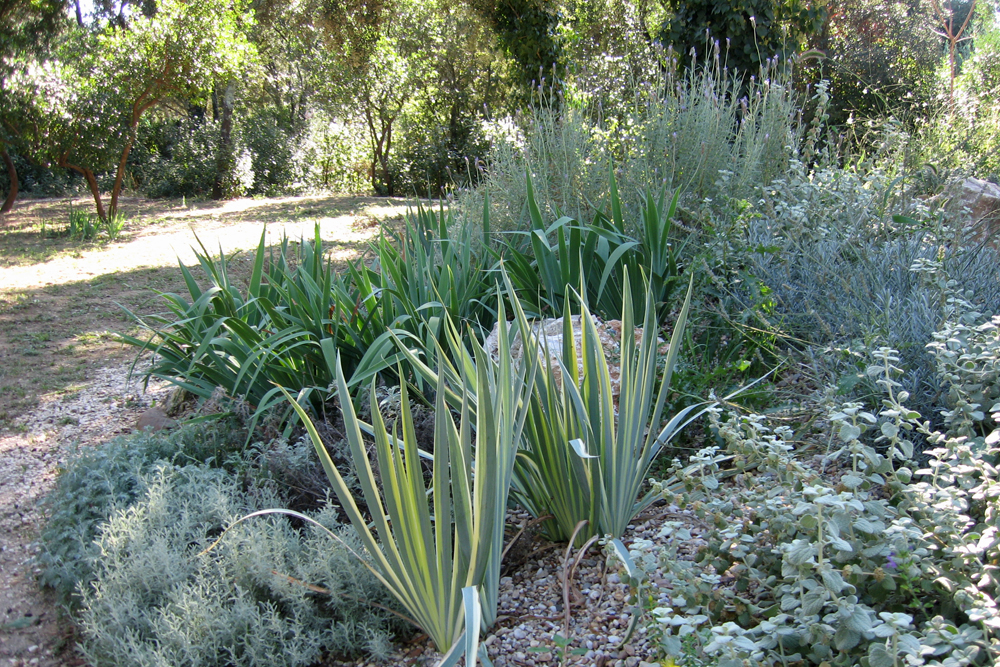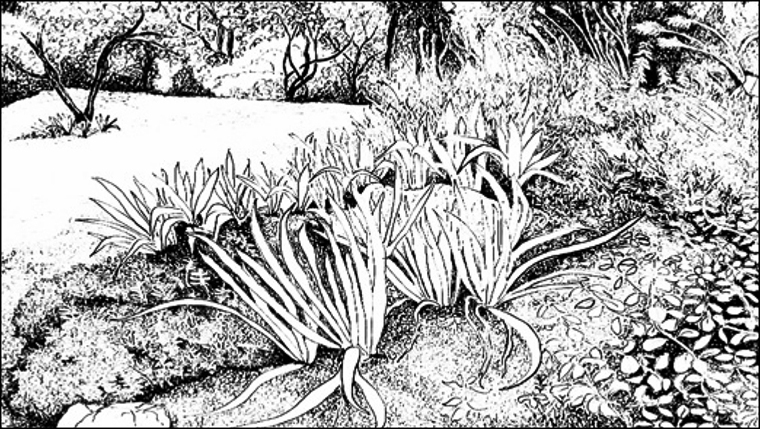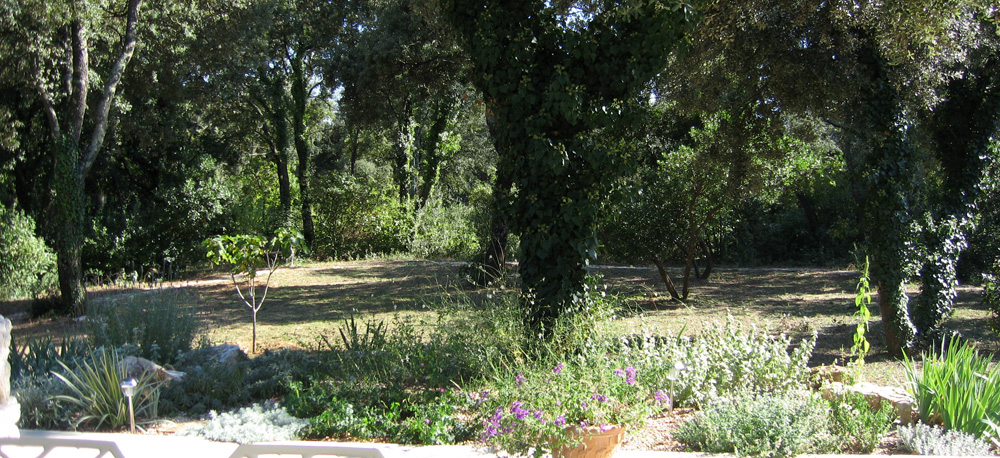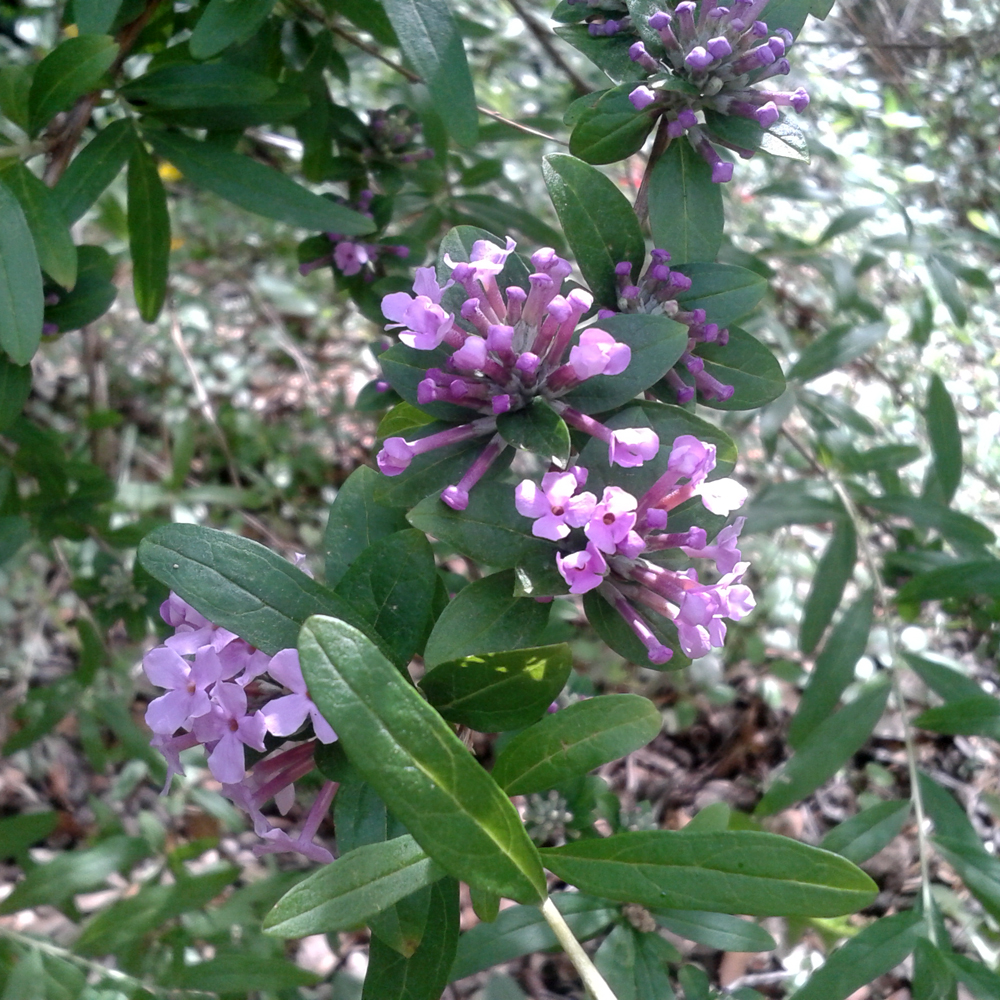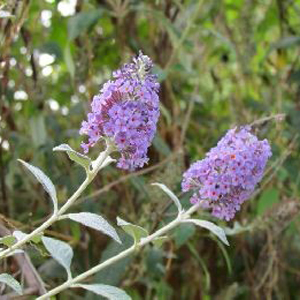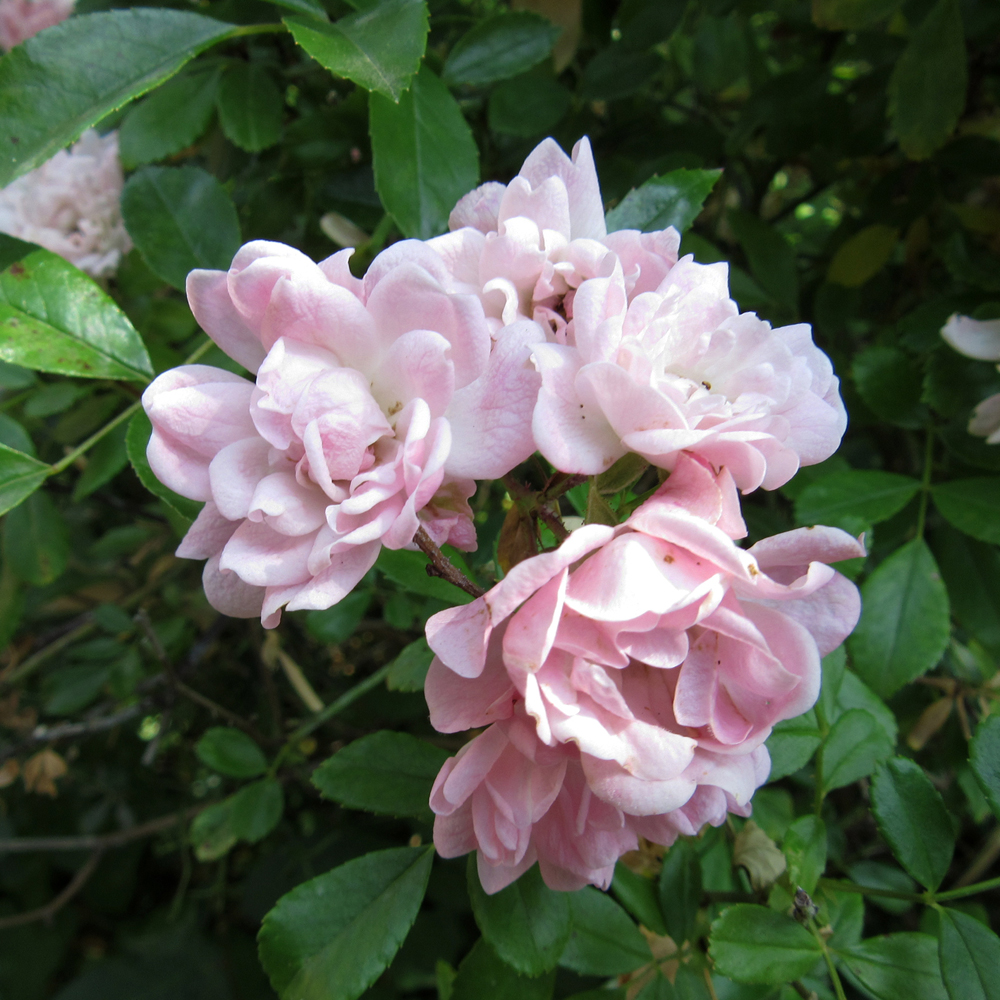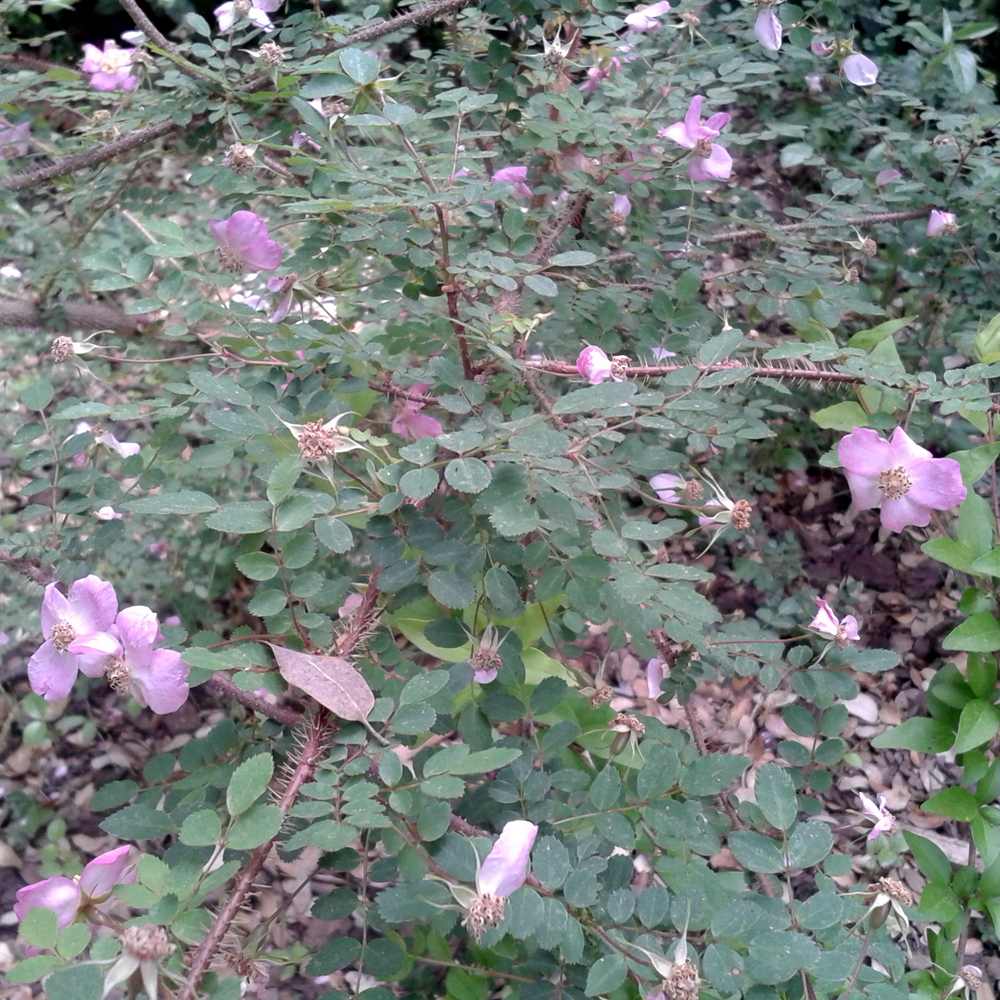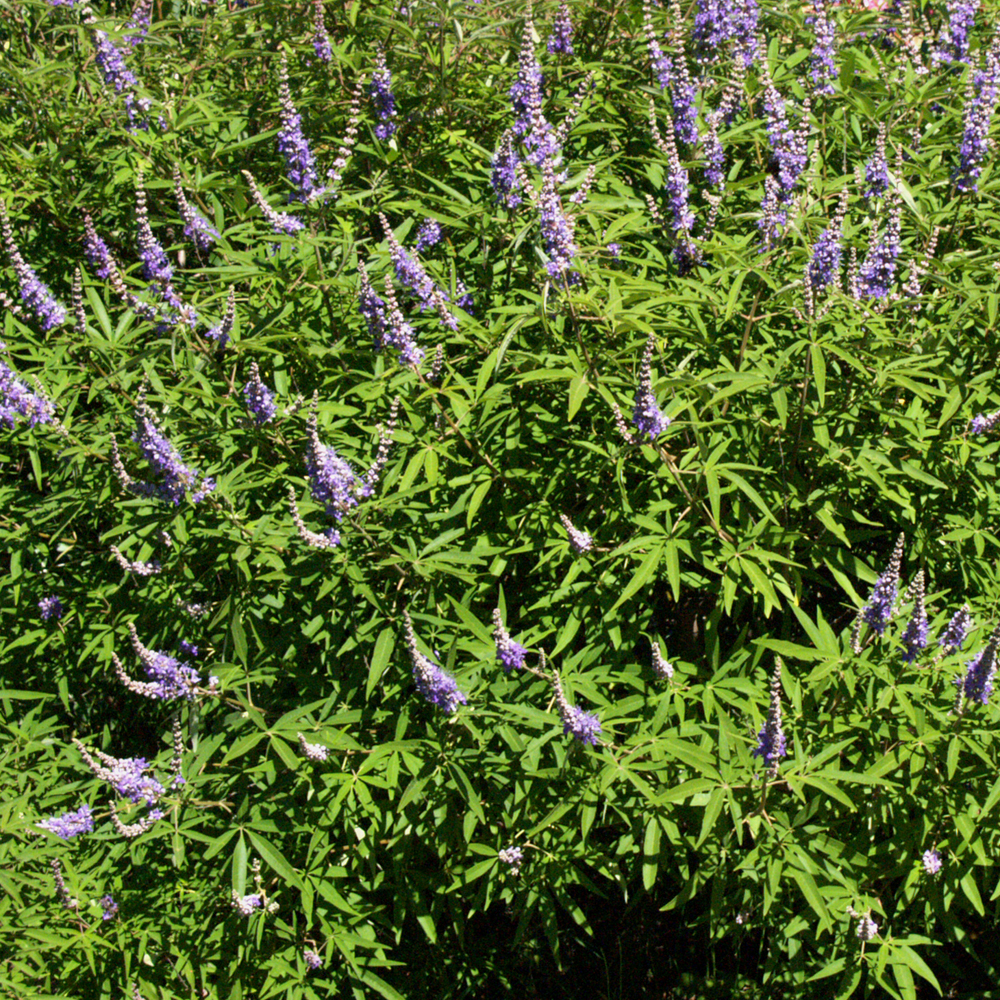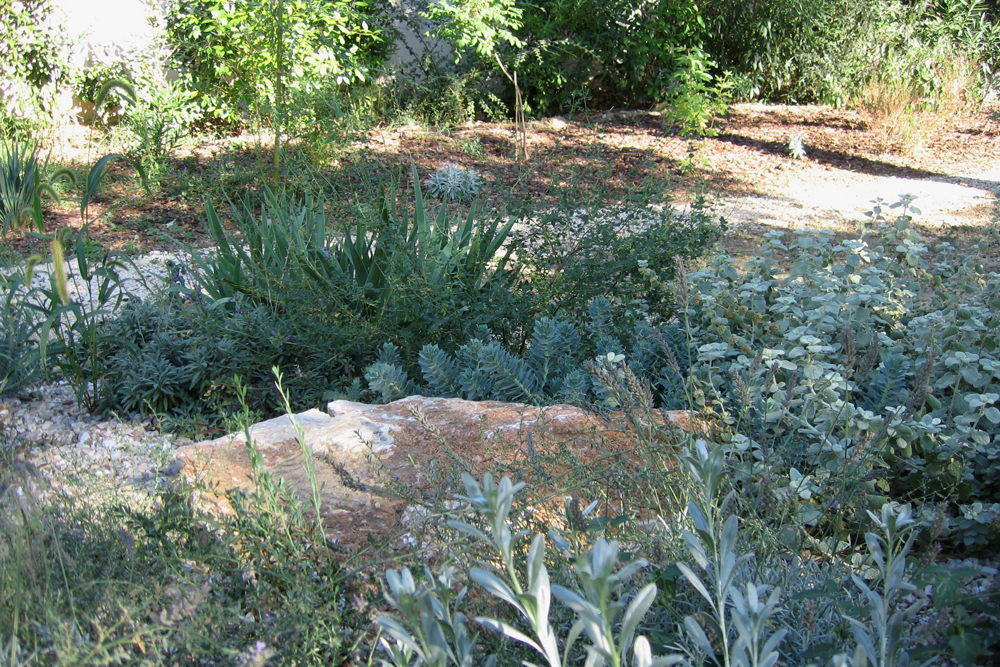Garden Diaries / Journaux de jardins
Jocelyn’s garden in the Gard
Click on the images to enlarge them / Cliquez sur les images pour les agrandir
A Garden Design Workshop led by Hilary Ivey
In February 2010, eighteen members gathered at Jocelyn van Riemsdijk’s new home to learn how to measure and draw up the layout of a garden.At the back, the land had been cleared of undergrowth and old tree roots removed. We looked out on to a muddy rectangle with some oak, arbutus and Viburnum tinus.
Jocelyn started by telling us what she wanted. The house is built on what was an old forest and Jocelyn would like to retain the feel of the forest and garrigue with a natural garden, low in water usage and maintenance. As for plants, she favours aromatic and grey-leaved plants though she has a special interest in plants from the Far East.
Hilary Ivey, a member who is a qualified garden designer, then went through a check list of things to consider: existing features and changes desired and how to draw up a plan and position existing objects on it – in this case, mostly trees. This involved learning about triangulation, far simpler than I had supposed.
Hilary provided each of us with a large plan showing an outline of the house and perimeter fencing. As the sun appeared, out we went with tape measures and drawing pads, one team tackled the north-facing front of the house and the rest of us put on boots, as it was muddy from heavy rain the day before, and went into the future back garden.
We ‘triangulated’ the trees, imagined steps and paths,seeing carpets of cyclamen and cascades of roses, someone was even spotted crouching down to estimate the exact view from the bed in the master bedroom. By the end of the afternoon, we had come up with suggestions that were, we hoped, respectful of Jocelyn’s wishes and from which she will be able to select ideas for the layout of her garden and some of the plants that she might put in it.
We hope, in the autumn, to meet again for another ‘hands on’ day helping Jocelyn to plant.
Text: Katharine Fedden
Planting Day
In October, we met at Jocelyn’s house for the second stage of our project. This time, thirteen enthusiastic members arrived armed with spades and trowels ready to implement the design drawn up by Hilary.
The areas to be planted comprised a large south-facing semi-circular bank at the rear of the house and a side border. The ground had already been well prepared and planting conditions, after some earlier rain, were perfect.
We then began the task of setting out, then digging in, a superb range of over thirty different plants including varieties of artemisia, ballota, cistus, geranium, helichrysum, lavender, rosemary, iris, salvia, sisyrinchium and santolina.
Hilary had selected plants which were very suitable for a water-wise garden and taken into account Jocelyn’s preference for aromatic and grey-leaved plants.
The full plant list, with photographs, can be found here.
A typically generous lunch followed the hard work with almost everyone having discovered a new variety or planting combination to try in their own garden.
Above all, our host was delighted with the finished result.
Text: Duncan Munford
Photos: Christine Savage
Editor’s note: Hilary now lives and works in Brittany. MGF is very grateful to her for agreeing to share the plant list and planting plan.
In April 2012 a group of members visited the garden.
A path around the garden had been created using a foundation of crushed rock gravel, then a layer of geo-textile and finally a covering of well-compacted fine gravel.
After the plants had been put into the sloping bank it was mulched with medium (15/25) gravel.
To the north-west of the path the land remains much as it was when Jocelyn arrived, with a mixture of local vegetation including Quercus ilex, Arbutus unedo and Viburnum tinus. The central area has had some trees planted in it, including a fig, an almond and an Acer monspessulanum. An Albizia julibrissin did not survive and was replaced by a quince.
The eastern edge of the garden has been developed with plants from the mountainous monsoon area of China: Rosa chinensis, buddleja and photinia. Although these plants can manage with very little water, they are watered twice a week in very dry weather in order to produce large flowers to delight the butterflies.
Text and photographs: Ann Killingback and Michael Pritchard
A Garden in the Garrigue / Un Jardin dans la Garrigue
Jocelyn wrote this article for ‘Gardening in Languedoc and Provence’ a book published by MGS Languedoc in July 2013, to celebrate its tenth anniversary.
Jocelyn a écrit cet article pour « Gardening in Languedoc and Provence », un livre publié par MGS Languedoc en juillet 2013, pour célébrer son dixième anniversaire.
I live in an oak wood. Every morning I open my bedroom shutters & look out into a sea of dark green lightened by shafts of sunlight touching the canopy in the wood beyond. The evergreen oaks (Quercus ilex), and arbutus (Arbutus unedo) display their bare trunks rugged with lichen or elegantly smooth & rich-coloured.
J’habite dans un bois de chênes. Chaque matin j’ouvre les volets de ma chambre et je regarde une mer de vert foncé éclairée par des rayons de soleil touchant la canopée dans la forêt au fond. Les feuilles persistantes des chênes (Quercus ilex) et des arbousiers (Arbutus unedo) exposent leurs troncs nus revêtus de lichen ou élégamment lisses et riche en couleur.
When I arrived at my new home in Saint-Siffret, in the autumn of 2009, the garden was a wilderness. The ground was covered with re-growth from the oaks after a severe pruning two years previously. All the lower branches of the trees had been removed up to at least two and a half metres. The potential was great: the high canopy let in plenty of sunlight and made a serious garden possible.
Quand je suis arrivée chez moi à Saint-Siffret, en l’automne de 2009, le jardin était un désert. Le sol était couvert de rejets des chênes suivant une taille trop sévère, deux ans auparavant. Toutes les branches basses des arbres avaient été éliminées jusqu’à deux mètres et demi de hauteur. Le potentiel était énorme : la haute canopée laisse filtrer la lumière du soleil ce qui donnait la possibilité d’un jardin fabuleux.
Christine Savage, Hilary Ivey and I had decided to make the development of the garden a branch project. Many members had contributed towards the purchase of new plants when I retired as Branch Head and had offered their labour too! We organised a planning day in February 2010, led by Hilary. By this time a large area under the trees had been cleared and roughly rotovated. People could therefore wander at will and draw up their own plans. My aims were clear. I wanted a garden which would be easy to maintain, economical in water use and run largely on organic lines. But above all, a garden ecologically rich, with berried shrubs for the birds, pollen-rich plants for the insects, good evergreen cover for small mammals and birds, sunny rocks for the lizards and space (and catmint) for the local cats.
Christine Savage, Hilary Ivey et moi ont décidé de faire, de la mise au point du jardin, un projet pour les membres. De nombreux membres ont contribué à l’achat de nouvelles plantes lorsque j’ai pris ma retraite en tant que présidente de la branche, et avaient offert leur main-d’œuvre en plus! Nous avons organisé une journée de planification en février 2010, dirigée par Hilary. A cette époque, un grand espace sous les arbres avait été dégagé et les environs travaillés au motoculteur. Les membres ont donc pu se promener tranquillement et établir leurs propres plans. Mes objectifs étaient clairs. Je voulais un jardin qui serait facile à entretenir, économique en arrosage et fonctionne en grande partie sur des lignes organiques. Mais surtout, un jardin écologiquement riche, avec des arbustes à graines pour les oiseaux, des plantes riches en pollen pour les insectes, une bonne couverture de feuillage persistant pour les petits mammifères et les oiseaux, des rochers ensoleillés pour les lézards et de l’espace (et de la cataire) pour les chats du coin.
The site is a rough rectangle of about 1700 sq metres, running north to south. On the north side is a gravel courtyard, increasingly devoted to wild flowers and a north facing, covered porch. On the south side the house has large sliding windows leading on to a sunny terrace extending over 60 sq. metres. Four stone steps lead down to the lower garden, with a gravel path running down from the terrace at each side, curving to join up at the far end. The west side of the garden is largely wild, with Viburnum tinus dominant but also common box (Buxus sempervirens), wild olive trees and many small garrigue plants, including Cistus albidus.
Le site est un rectangle d’environ 1700 mètres carrés, s’étendant du nord au sud. Sur le côté nord se trouve une cour de gravier, de plus en plus consacrée aux fleurs sauvages et une face au nord, véranda couverte. Le côté sud de la maison dispose de grandes baies vitrées donnant sur une terrasse ensoleillée qui s’étend sur 60 mètres carrés. Quatre marches en pierre mènent au jardin du bas, avec un chemin de gravier depuis la terrasse qui descend de chaque côté, se courbant pour se rejoindre toute au bout. Le côté ouest du jardin est en grande partie sauvage, avec Viburnum tinus dominante, mais également du buis (Buxus sempervirens), d’oliviers sauvages et de nombreuses petites plantes de garrigue, y compris des Cistus albidus.
There is a long border on the east side planted with buddleias (Buddleja officinalis, B. alternifolia and B. Lochinch), and china hybrid roses including ‘Perle d’Or’, ’Little White Pet’, ’The Fairy’ and ‘Blush Noisette’, as well as Rosa farreri ‘Persetosa’ and Rosa glauca. I have also planted Vitex agnus-castus and many small Mediterranean shrubs and bulbs. To the rear is an evergreen hedge, with Elaeagnus x submacrophylla (syn. Elaeagnus x ebbingei), Laurus nobilis and white oleanders. All the cultivated beds were rotovated and spread with large quantities of good soil, though not too rich, as the Saint-Siffret clay over rock is notoriously difficult to work.
Il y a une longue bordure du côté est, planté de buddleias, Buddleja officinalis, B. alternifolia et B. ‘Lochinch‘, et des rosiers hybrides, y compris Rosa ‘Perle d’Or’, Rosa ‘Little White Pet’, R. ‘The Fairy’ et R. ‘Blush Noisette’, ainsi que R. farreri ‘Persetosa’ et Rosa glauca. J’ai aussi planté un Vitex agnus-castus et de nombreux petits arbustes méditerranéens et des bulbes. A l’arrière il y a une haie à feuilles persistantes, avec Elaeagnus x submacrophylla (syn.E. x ebbingei), Laurus nobilis et de lauriers roses blancs. Toutes les plates-bandes ont été labourées avec un motoculteur en utilisant des quantités de bonne terre, pas trop riche, du fait que l’argile de Saint-Siffret sur la roche est notoirement difficile à travailler.
The bank sloping down from the terrace to the lower garden has become a rock garden, full of Mediterranean sun-loving plants, set out according to a brilliant design by Hilary Ivey. New soil was added, with gravel to give sharp drainage, and large rocks from a local quarry were placed to create microclimates for plants with special needs. The original planting was done by members on the Great Planting Day in early October 2010. The plants largely came from Pépinière Filippi, although some have since been replaced.
The great successes include Rosmarinus officinalis ‘Boule’, and other rosemary cultivars, Lavandula x intermedia ‘Grosso’ and ‘Alba’, Artemisia lanata, Centaurea bella, Ballota acetabulosa, many sages including Salvia chamaedryoides, S. blancoana (syn. S. lavandulifolia subs. blancoana) and S. microphylla and various geraniums. These plants create a sea of grey, mauve, blue and pink, usually alive with bees, butterflies and humming-bird hawk moths. Euphorbias add an acid greeny-yellow note in the spring, and wild Iris germanica and Iris pallida variegata, both white and yellow, add height and texture. In the spring, Cyclamen coum, wild narcissi and species tulips, as well as scillas, ixiolirion and other bulbs, add liveliness and bright colours. Some plants come and go, but the overall effect remains harmonious and my cat, Livi, and the lizards love the stones.
The centre of the garden, under the trees, has evolved into a green carpet of grass, weeds and wild flowers, interesting fungi and brilliant mosses. This is strimmed from time to time, but never watered. I have planted a fig tree, an almond, a judas tree (Cercis siliquastrum) and a quince and there are also clumps of iris, Narcissus poeticus, Cistus albidus and rosemary. The whole garden is, if not maintenance free, easy to maintain. The rock garden is dressed with gravel and never watered apart from new planting. The east border, heavily mulched, is watered, if necessary, twice a week and then only the roses, some buddleias and other plants from Western China.
My garden has lived up to all my hopes and dreams Thank you MGS Languedoc for making it all possible.
Text: Jocelyn van Riemsdijk
Photos: MGF Photo library
This plant list was created by MGF member and garden designer, Hilary Ivey, for the garden in Jocelyn’s new home in Saint-Siffret. Jocelyn was the branch head of MGS Languedoc for its first five years and a founder member of MGF.
La descente de la terrasse vers le jardin du bas est devenue un jardin de rocaille, plein de plantes méditerranéennes qui adorent le soleil, l’ensemble brillamment dessiné par Hilary Ivey. De la terre propre a été ajoutée, contenant du gravier pour donner un drainage musclé, et de grosses pierres d’une carrière locale ont été posées pour créer des microclimats pour les plantes ayant des besoins spéciaux. La plantation initiale a été faite par les membres de la société pendant ‘la Grande Journée de plantation’ au début octobre 2010. Les plantes proviennent en grande partie de la Pépinière Filippi, même si certaines ont depuis été remplacées.
Les grands succès incluant Rosmarinus officinalis ‘Boule’ et les cultivars d’autres romarin, Lavandula x intermedia ‘Grosso’ et ‘Alba’, Artemisia lanata, Centaurea bella, Ballota acetabulosa, y compris de nombreux sauges Salvia chamaedryoides, S. blancoana (syn. S. lavandulifolia ssp. blancoana) et S. microphylla et plusieurs géraniums. Ces plantes créent une mer de gris, mauve, bleu et rose, habituellement fourmillant d’abeilles, papillons et mites sphinx colibri. Les euphorbes ajoutent une note vert-jaune acide au printemps, et les Iris x germanica sauvages et I. pallida ‘Variegata’, blanc et jaune, ajoutent eux de la hauteur et de la texture. Au printemps, des Cyclamen coum, des narcisses et tulipes sauvages, ainsi que des scilles, un ixiolirion et d’autres bulbes, ajoutent la vivacité et des couleurs vives. Certaines plantes arrivent et partent, mais l’effet global reste harmonieux et mon chat, Livi, et les lézards, adorent les cailloux.
Le centre du jardin, sous les arbres, a évolué pour devenir un tapis vert de gazon, de mauvaises herbes et de fleurs sauvage, de champignons sauvages intéressants et de mousses brillantes. Ce centre du jardin est débroussaillé de temps en temps, mais jamais arrosé. J’ai planté un figuier, un amandier, un arbre de Judée, Cercis siliquastrum et un cognassier, et il y a aussi des touffes d’iris, Narcissus poeticus, Cistus albidus et du romarin. L’ensemble du jardin est facile à entretenir. Le jardin de rocaille est habillé de gravier et n’est jamais arrosé en dehors des plantations nouvelles. La plate-bande est arrosée, si nécessaire, deux fois par semaine mais seulement les rosiers, quelques buddleias et d’autres plantes d’origine de l’Ouest de la Chine.
Mon jardin est à la hauteur de toutes mes espérances et de mes rêves, merci à la MGS Languedoc pour avoir rendu tout cela possible.
Cette liste de plantes a été créée par Hilary Ivey, paysagiste et membre du MGF, pour le jardin de la nouvelle maison de Jocelyn à Saint-Siffret. Jocelyn a été le chef de MGS Languedoc pendant ses cinq premières années et un membre fondateur de MGF.
![]()

